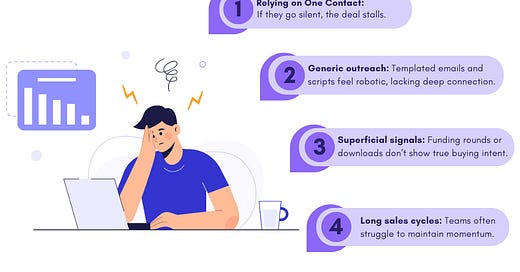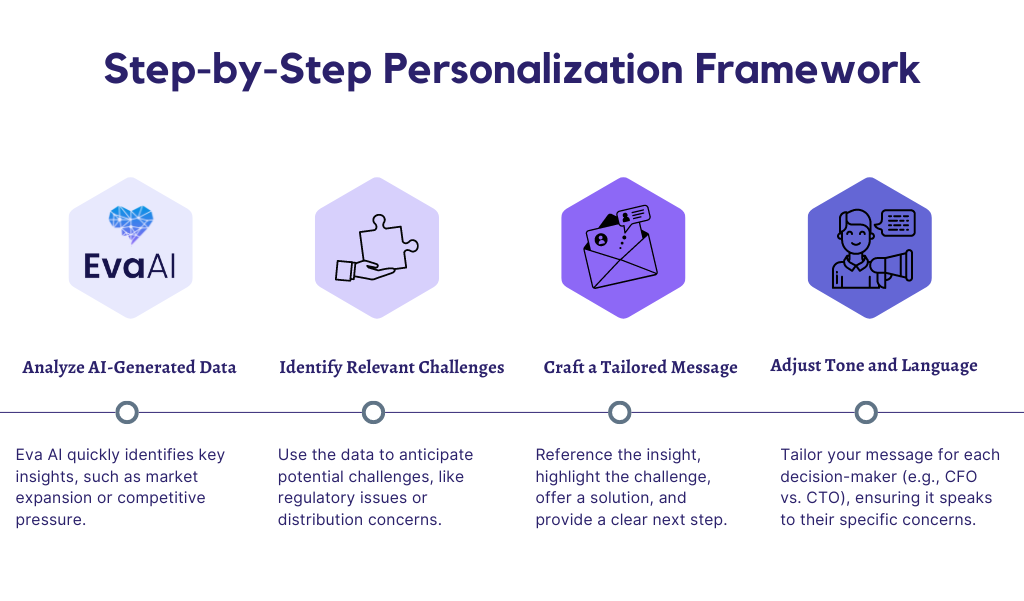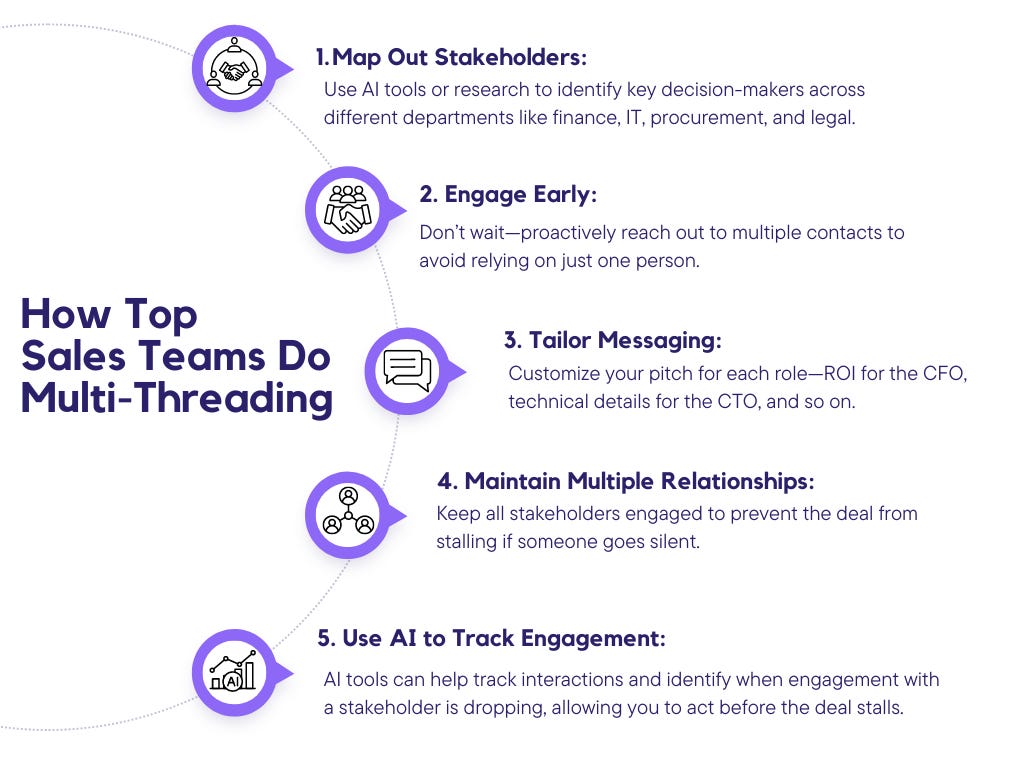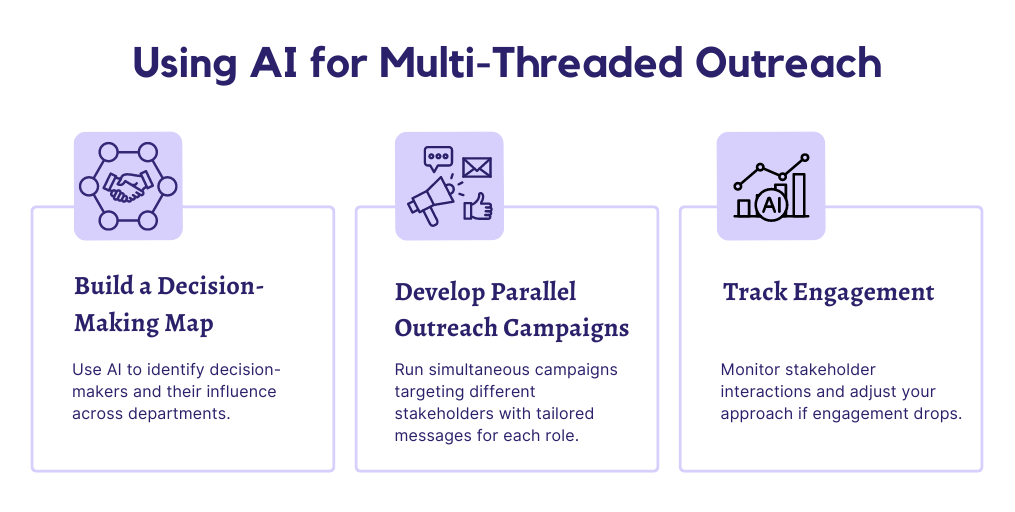How top sales teams are cracking enterprise accounts?
Discover how top sales teams crack enterprise accounts by leveraging AI-driven insights, multi-threaded outreach, and personalized sales strategies.
The idea to write this newsletter came to me after a frustrating sales meeting that stuck with me.
We are chasing enterprise accounts from the past 6 months. We had invested heavily in AI tools to crack enterprise accounts.
We believed we had everything set up — the right signals, the best tools, and a solid process.
But something wasn’t clicking. We lost a couple of deals at the final stage, deals that should’ve closed.
One particular deal stood out.
The team had nurtured a relationship with a key decision-maker for months. It seemed like a sure win. But as they approached closing, their contact went completely silent.
No calls, no emails, just vanished.
When they finally heard back weeks later, they learned the contact had left the company, and with them, all their hard work was gone.
The deal was dead.
It wasn’t the first time I’d seen this happen. But this time, we are at the closing stage with most opportunities. Just because we were able to identify pain based insights, hyper-personalize our calls, emails and linkedin, and multi-thread… Thanks to Eva AI.
It made me realize there’s a gap between what technology can do and what exactly is required for execution.
You can have the most advanced AI, but if you’re not multi-threading, hyper-personalizing outreach, and reading the insights correctly, you’re still going to lose.
This is when I knew a newsletter was needed.
Sales teams needed guidance—not just on using AI but on how to use it alongside human creativity, intuition, and strategy.
That’s where this newsletter comes in: not just another piece of content, but a practical guide on cracking enterprise accounts by blending AI with the timeless fundamentals of sales.
What sets top sales teams apart?
Top sales teams do face the same roadblocks as other sales teams when tackling enterprise accounts.
But what sets them apart?
They’ve found ways to break through these challenges, using smart strategies and adopting tools that regular teams struggle to implement effectively.
Here are the top challenges that sales teams face when dealing with enterprise accounts :
Challenge 1: Most sales teams rely heavily on one contact within the enterprise. This is risky. If that person goes silent, the entire deal stalls.
Challenge 2: Sales teams often use templated outreach i.e. templated emails with keywords, generic call scripts, linkedin automations. It feels robotic and doesn’t connect deeply with enterprise-level prospects.
Challenge 3: Sales teams often focus on superficial signals like funding rounds or hiring sprees or G2 Search or eBook downloads, which don’t always indicate real buying intent.
Challenge 4: Enterprise sales cycles are long, and sales teams often struggle to keep momentum.
Below are the insights on how top teams have cracked these challenges:
1. Multi-Threaded Conversations
Top sales teams are multi-threaded. They engage multiple decision-makers and influencers across departments, ensuring the deal stays alive even if one contact falls off the radar.
Process:
Map out the organization using AI tools to identify key stakeholders.
Tailor outreach based on the role (CFO, CTO, Operations Head).
Engage them simultaneously, but with messaging that speaks directly to their concerns. You would need solid account research and prospect research for this.
2. Personalizing at Scale Without Losing the Human Touch
Top sales teams use AI insights for deeper personalization but balance it with human touch. They craft emails and call scripts that feel unique to each stakeholder, based on real pain points, not just generic data.
Process:
Use AI to identify signals like leadership changes, competitive pressure, or expansion.
Personalize based on these pain points but add a human angle. E.g., mention how similar companies overcame similar challenges.
Avoid over-reliance on automation—leave room for genuine conversation.
One sales team used AI to spot that a prospect was expanding into the APAC region. Instead of sending a bland “Congrats on the expansion” email, they dove into the potential operational challenges the company would face, offering a solution upfront.
3. Not Just Signal-Led, But Pain-Led Prospecting
The top teams go beyond signals. They focus on pain-led prospecting. Instead of assuming interest based on external signals, they dig deeper into the company’s actual challenges, like budget cuts, business priorities, leadership transitions, or market shifts.
Process:
Use AI tools (like Evabot) to track pain-based signals like next year business priorities, negative earnings reports or internal restructuring.
Prioritize accounts based on real pain points, not just online activity.
Example:
A cybersecurity sales team closed a deal after targeting a company that had recently suffered a high-profile data breach. Their outreach focused directly on the need for a stronger security posture, aligning with the company’s urgent pain point.
4. Reducing Sales Cycle Length Through Multi-Channel Outreach
Top teams reduce sales cycle length by using multi-channel outreach. They don’t rely on just one method (e.g., emails), but engage through multiple touchpoints—LinkedIn, email, cold calls, even in-person meetings.
Process:
Use AI tools to predict the best outreach channels for each stakeholder.
Combine cold calling 2.0 (using permission-based openers, auto call-prep notes with account research) with LinkedIn messages and email.
Engage prospects continuously without overwhelming them.
While top sales teams have mastered these strategies, there’s still room for growth, especially in refining personalization and using pain-based signals effectively.
Implementing the Process
Step 1: Identifying and Prioritizing the Right Signals
Top sales teams know that the first step to cracking enterprise accounts is identifying the right signals.
With AI tools generating massive amounts of data, the challenge isn’t finding leads—it’s figuring out which signals matter.
Most teams get flooded with signals like funding rounds, hiring spikes, leadership changes, and product launches.
These are supposed to help, but often create more confusion than clarity.
Common Signals Sales Teams Chase:
- Funding rounds.
- Website visits.
- Job postings.
- Product launches.
While these might seem like good opportunities, they often waste time on dead-end accounts that aren’t ready to buy.
Instead of chasing every signal, top sales teams focus on pain-based signals. These signals reflect a company’s immediate challenge, which means they’re far more likely to be in buying mode.
Pain-based signals dig deeper than surface-level intent. They reveal the real problems that companies need to solve right now.
Key Pain-Based Signals:
- Leadership Changes: New leadership often means new budgets and strategies. For example, a new CTO might push for a tech overhaul.
- Competitive Losses: When your prospect’s competitor loses a major deal, it creates an opening for you.
- Business Priorities: When a prospect has mentioned that they are gonna expand in APAC in their 10K Reports, they would be needing on ground sales teams and all the resources to build a business.
- Budget Constraints: A company facing financial issues may urgently seek cost-effective solutions.
- Security Breaches: Companies that experience security issues need immediate help, making them high-priority leads.
So, how do you configure AI to find these pain points?
It’s simple. Evabot does everything for you…
1. Connect to the Right Data Sources:
Eva AI pulls account insights from news articles, earnings reports, social media, and SEC filings.
2. Configure for Specific Pain Signals:
Just add keywords to track and AI will give you insights on signals that indicate real purchasing intent.
3. AI-Based Lead Scoring:
Eva AI Rank leads with pain-based. For instance, a company announcing missed earnings should score higher than one just announcing a product launch.
4. Set Up Alerts for Quick Action:
You receive a notification when high-value pain signals emerge, like a security breach or a new CEO. This allows your sales team to react quickly.
While it’s tempting to chase any lead that shows interest, the quality of the signal matters more than the quantity.
Prioritizing the right signals not only saves time but also improves the quality of engagement. Sales teams that chase every lead often burn out and fail to connect with prospects who are actually in the market for a solution.
- Top Teams: Focus on pain-based signals and high-value opportunities.
- Other Teams: Chase irrelevant signals that don’t lead to conversions.
To crack enterprise accounts, you need to get better at filtering out the noise and prioritizing signals that indicate real pain and purchasing intent.
AI is only as good as the way you program it, and sales teams that optimize AI for pain-based signals will be the ones closing the biggest deals.
Step 2: Hyper-Personalized Outreach Using AI Insights
AI can research leads, analyze data, and even generate content. But there's one thing AI struggles with: human creativity and empathy.
While AI is great at generating insights, over-relying on it without adding a personal touch can lead to robotic, ineffective messaging.
Too many sales teams think that personalizing an email means simply adding the recipient's name or company or job change or college mentions.
But that’s not “personalization” anymore.
Real personalization goes much deeper. It’s about understanding the prospect’s unique pain points, context, and motivations.
Basic Personalization:
“Hi Sarah, I see your company just raised $5M in Series A funding.”
Deeper Personalization:
“Hi Sarah, I noticed your company just raised $5M. Expansion often leads to new operational challenges, especially when scaling your tech infrastructure. Many of our clients faced similar issues, and we helped them streamline their operations.”
The difference?
The second approach connects with the recipient’s likely pain points. It’s not just about name-dropping; it’s about showing you understand their business and the challenges they face.
Combining AI’s data-analyzing capabilities with human creativity can lead to hyper-personalized outreach that resonates with prospects.
AI gives you the insights, but it’s up to the sales rep to humanize it.
Here’s a framework for building AI-led outreach that’s still deeply personal and relevant.
Step-by-Step Personalization Framework. This is minutes work with Evabot
1. Analyze AI-Generated Data:
Eva AI generates insights that typically take hours for a sales rep if done manually. For example, it might show that your prospect has expanded into a new market and is facing competitive pressure within just 1 min.
2. Identify Relevant Challenges:
Eva AI uses your product/service details and context to anticipate potential challenges. For instance, if the company is expanding into a new region, they may be dealing with unfamiliar regulatory landscapes or distribution issues.
3. Craft a Tailored Message:
Eva AI hyper-personalizes your outreach by addressing the challenges it has identified and marked by you..
- Opening: Reference the insight (e.g., “I noticed your company recently expanded into the APAC region…”).
- Problem Statement: Acknowledge the challenge (e.g., “Expansion often comes with regulatory hurdles. Many of our clients struggle with compliance in new markets.”).
- Value Proposition: Offer a tailored solution (e.g., “Our platform helps companies navigate complex regulatory landscapes seamlessly…”).
- Call to Action: Provide a clear next step (e.g., “I’d love to discuss how we’ve helped similar companies streamline their compliance processes.”).
4. Adjust Tone and Language for the Decision-Maker:
The messaging you use for a CTO will be different from that for a CFO. Eva AI uses different frameworks and guides you.
AI offers incredible opportunities to scale outreach (calls, linkedin, emails) and gather detailed insights. But it can’t replace the need for human connection. To crack enterprise accounts, sales teams need to go beyond data and create communication that feels personal, empathetic, and deeply relevant to each prospect.
Step 3: Multi-Threading Across Decision-Makers
Top sales teams use multi-threading—engaging multiple stakeholders within an organization from the start. This approach spreads risk, builds deeper relationships, and increases the likelihood of deal success.
Enterprise sales involve multiple decision-makers, each with different priorities. Relying on just one person increases the chances of your deal stalling. This can happen when:
- Your contact loses interest or gets swamped with other priorities.
- They lack the authority to finalize decisions.
- They leave the company, and no one else knows about the deal.
- Communication breaks down without explanation, leaving you in the dark.
Failing to engage multiple decision-makers can lead to missed opportunities and stalled deals.
Here’s how top sales teams do multi-threading:
1. Map Out Stakeholders: Use AI tools or research to identify key decision-makers across different departments like finance, IT, procurement, and legal.
2. Engage Early: Don’t wait for your main contact to introduce you to others. Proactively reach out to multiple stakeholders.
3. Tailor Messaging: Each decision-maker has different concerns. The CFO will care about ROI, while the CTO focuses on technical feasibility. Adjust your messaging accordingly.
4. Maintain Multiple Relationships: Keep in touch with all stakeholders regularly. This way, if one person goes silent, others can still help move the deal forward.
5. Use AI to Track Engagement: AI tools can help track interactions and identify when engagement with a stakeholder is dropping, allowing you to act before the deal stalls.
Using AI to Map Decision-Makers and Multi-Thread Outreach
AI can be your secret weapon in multi-threaded outreach. It helps map decision-making hierarchies and identify key influencers within an organization. Here’s how top sales teams leverage AI:
1. Build a Decision-Making Map: AI tools can help you identify decision-makers across departments, showing who has the most influence and which departments are involved.
2. Develop Parallel Outreach Campaigns: Run simultaneous campaigns targeting different stakeholders, each with a message tailored to their role.
3. Track Engagement: Use AI tools to monitor which stakeholders are engaging with your content, and adjust your strategy if one group starts to drop off.
Multi-threading is essential for cracking enterprise accounts. By engaging multiple decision-makers, tailoring your messaging, and using AI to track progress, you can prevent deals from stalling and close them faster. Relying on a single point of contact is risky—diversify your relationships, and your deals will thrive.
Would you like to evaluate “Evabot AI” for signal-led prospecting and book more meetings? Book a meeting on the button below.
If you’re not a subscriber, here’s what you missed earlier:
Subscribe to get access to our weekly posts on Prospecting, Automation, AI, Revenue Growth and Lead Generation.








